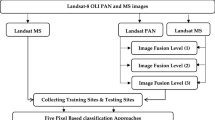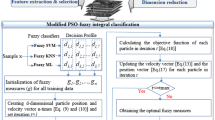Abstract
In order to reduce the overuse of herbicides, an automatic spraying system can be utilized, assisted with machine vision-based techniques to accurately target weeds. In this paper, a fusion-based structure has been proposed for weed detection in visible and thermal images of paddy fields. Due to the lack of publicly available multispectral datasets in this topic, first, a freely accessible dataset was generated including 100 pairs of visible and thermal images of rice and weeds. In this new dataset, the segmented plants were labeled into two groups of rice and weeds. A feature vector including 15 morphological, 12 spectral, 10 textural and 11 new thermal features was extracted from segmented objects. The proposed thermal features were extracted from thermal images, while other types of features were extracted from visible/thermal pairs. Then, a genetic algorithm (GA) was used for optimized feature selection. Next, multiple late and early fusion structures at the decision level were developed and compared for weed detection purposes. Applied fusion structures include: multilayer perceptron neural network (MLP), extreme learning machines (ELM) and extreme learning machines ensembles (ELM-E) artificial neural networks. The best results were obtained by ELM with an accuracy of 98.08% in late fusion structure with GA. The best results for classifying plants in visible images were related to the morphological descriptor and the best results for thermal images belonged to the proposed descriptor.









Similar content being viewed by others
Abbreviations
- SSWM:
-
Site-specific weed management
- FCN:
-
Fully convolutional networks
- NGRDI:
-
Normalized green red difference index
- GLCM:
-
Gray-level co-occurrence matrix
- RF:
-
Random forest
- r:
-
Normalized value of the R component of the image
- b:
-
Normalized value of the B component of the image
- TP:
-
True positive or pixels correctly segmented as foreground
- TN:
-
True negative or pixels correctly detected as background
- CFI:
-
Choquet fuzzy integral
- DES:
-
Dempster Shafer theory
- LBP:
-
Local binary pattern
- ELM-E:
-
Extreme learning machines ensembles
- µm:
-
Micrometre
- nm:
-
Nanometre
- FD:
-
Fourier descriptor
- ANN:
-
Artificial neural networks
- EA:
-
Evolutionary algorithms
- RGB:
-
Red, green, and blue components of image
- MPA:
-
Mean pixel accuracy
- NDVI:
-
Normalized difference vegetation index
- MLP:
-
Multilayer perceptron neural network
- SVM:
-
Support vector machines
- SPA:
-
Successive projection algorithm
- g:
-
Normalized value of the G component of the image
- FP:
-
False positive or pixels falsely segmented as foreground
- FN:
-
True negative or pixels falsely detected as background
- SFI:
-
Sugeno fuzzy integral
- FMCDM:
-
Fuzzy multicriteria decision making
- ELM:
-
Extreme learning machines
- GA:
-
Genetic algorithm
- SP:
-
Select pressure
- mm:
-
Millimeters
- MI:
-
Moment invariants
- TSD:
-
Tensor scale descriptor
- ACO:
-
Ant colony optimization algorithm
References
Ahmed, F., Al-Mamun, H. A., Bari, A. H., Hossain, E., & Kwan, P. (2012). Classification of crops and weeds from digital images: A support vector machine approach. Crop Protection, 40, 98–104.
Akbarzadeh, S., Paap, A., Ahderom, S., Apopei, B., & Alameh, K. (2018). Plant discrimination by support vector machine classifier based on spectral reflectance. Computers and Electronics in Agriculture, 148, 250–258.
Asvadi, A., Karami, M., & Baleghi, Y. (2011). Efficient object tracking using optimized K-means segmentation and radial basis function neural networks. International Journal of Information and Communication Technology, 4, 29–39.
Asvadi, A., Mahdavinataj, H., Karami, M., & Baleghi, Y. (2013). Incremental discriminative color object tracking. In International symposium on artificial intelligence and signal processing (pp. 71–81). Springer.
Bakhshipour, A., & Jafari, A. (2018). Evaluation of support vector machine and artificial neural networks in weed detection using shape features. Computers and Electronics in Agriculture, 145, 153–160.
Bakhshipour, A., Jafari, A., Nassiri, S. M., & Zare, D. (2017). Weed segmentation using texture features extracted from wavelet sub-images. Biosystems Engineering, 157, 1–12.
Barrero, O., & Perdomo, S. A. (2018). RGB and multispectral UAV image fusion for Gramineae weed detection in rice fields. Precision Agriculture, 19, 809–822.
Bharati, M. H., Liu, J. J., & MacGregor, J. F. (2004). Image texture analysis: Methods and comparisons. Chemometrics and Intelligent Laboratory Systems, 72, 57–71.
Brown, R. B., & Noble, S. D. (2005). Site-specific weed management: Sensing requirements—What do we need to see? Weed Science, 53, 252–258.
Cao, J., Lin, Z., Huang, G.-B., & Liu, N. (2012). Voting based extreme learning machine. Information Sciences, 185, 66–77.
Chaudhuri, B., & Bhattacharya, U. (2000). Efficient training and improved performance of multilayer perceptron in pattern classification. Neurocomputing, 34, 11–27.
Cheng, B., & Matson, E. T. (2015). A feature-based machine learning agent for automatic rice and weed discrimination. In International conference on artificial intelligence and soft computing (pp. 517–527). Springer.
Cvetković, S., Stojanović, M. B., & Nikolić, S. V. (2018). Hierarchical ELM ensembles for visual descriptor fusion. Information Fusion, 41, 16–24.
Doustfatemeh, I., & Baleghi, Y. (2016). Comprehensive urban area extraction from multispectral medium spatial resolution remote-sensing imagery based on a novel structural feature. International Journal of Remote Sensing, 37, 4225–4242.
Fawakherji, M., Potena, C., Pretto, A., Bloisi, D. D., & Nardi, D. (2021). Multi-spectral image synthesis for crop/weed segmentation in precision farming. Robotics and Autonomous Systems, 146, 103861.
Gokulnath, C. B., & Shantharajah, S. (2019). An optimized feature selection based on genetic approach and support vector machine for heart disease. Cluster Computing, 22, 14777–14787.
Guijarro, M., Pajares, G., Riomoros, I., Herrera, P., Burgos-Artizzu, X., & Ribeiro, A. (2011). Automatic segmentation of relevant textures in agricultural images. Computers and Electronics in Agriculture, 75, 75–83.
Hamuda, E., Glavin, M., & Jones, E. (2016). A survey of image processing techniques for plant extraction and segmentation in the field. Computers and Electronics in Agriculture, 125, 184–199.
Herrera, P. J., Dorado, J., & Ribeiro, Á. (2014). A novel approach for weed type classification based on shape descriptors and a fuzzy decision-making method. Sensors, 14, 15304–15324.
Hu, M.-K. (1962). Visual pattern recognition by moment invariants. IRE Transactions on Information Theory, 8, 179–187.
Huang, Z., & Leng, J. (2010). Analysis of Hu's moment invariants on image scaling and rotation. In 2010 2nd international conference on computer engineering and technology (pp. 476–480). IEEE.
Jensen, H. G., Jacobsen, L.-B., Pedersen, S. M., & Tavella, E. (2012). Socioeconomic impact of widespread adoption of precision farming and controlled traffic systems in Denmark. Precision Agriculture, 13, 661–677.
Kakooei, M., & Baleghi, Y. (2020). A two-level fusion for building irregularity detection in post-disaster VHR oblique images. Earth Science Informatics, 13, 459–477.
Liu, K., Li, Y., Xu, N., & Natarajan, P. (2018). Learn to combine modalities in multimodal deep learning. Preprint at http://arXiv.org/1805.11730
López Granados, F. (2011). Weed detection for site-specific weed management: Mapping and real-time approaches. Weed Research, 51, 1–11.
Ma, X., Deng, X., Qi, L., Jiang, Y., Li, H., Wang, Y., et al. (2019). Fully convolutional network for rice seedling and weed image segmentation at the seedling stage in paddy fields. PLoS ONE, 14, e0215676.
Mitchell, H. B. (2010). Image fusion: Theories, techniques and applications. Springer.
Montalvo, M., Guerrero, J. M., Romeo, J., Emmi, L., Guijarro, M., & Pajares, G. (2013). Automatic expert system for weeds/crops identification in images from maize fields. Expert Systems with Applications, 40, 75–82.
Nikbakhsh, N., & Baleghi, Y. (2019). A new fast method of image segmentation fusion using maximum mutual information. In 2019 27th Iranian conference on electrical engineering (ICEE) (pp. 1584–1588). IEEE.
Nikbakhsh, N., Baleghi, Y., & Agahi, H. (2019). Maximum mutual information and Tsallis entropy for unsupervised segmentation of tree leaves in natural scenes. Computers and Electronics in Agriculture, 162, 440–449.
Nikbakhsh, N., Baleghi, Y., & Agahi, H. (2020b). A novel approach for unsupervised image segmentation fusion of plant leaves based on G-mutual information. Machine Vision and Applications, 32, 1–12.
Nikbakhsh, N., Baleghi Damavandi, Y., & Agahi, H. (2020a). Plant classification in images of natural scenes using segmentations fusion. International Journal of Engineering, 33, 1743–1750.
Ojala, T., Pietikainen, M., & Maenpaa, T. (2002). Multiresolution gray-scale and rotation invariant texture classification with local binary patterns. IEEE Transactions on Pattern Analysis and Machine Intelligence, 24, 971–987.
Pandeya, Y. R., & Lee, J. (2021). Deep learning-based late fusion of multimodal information for emotion classification of music video. Multimedia Tools and Applications, 80, 2887–2905.
Rodrigo, M., Oturan, N., & Oturan, M. A. (2014). Electrochemically assisted remediation of pesticides in soils and water: A review. Chemical Reviews, 114, 8720–8745.
Shirzadifar, A., Bajwa, S., Nowatzki, J., & Shojaeiarani, J. (2020). Development of spectral indices for identifying glyphosate-resistant weeds. Computers and Electronics in Agriculture, 170, 105276.
Slaughter, D., Giles, D., & Downey, D. (2008). Autonomous robotic weed control systems: A review. Computers and Electronics in Agriculture, 61, 63–78.
Talbi, E. G., Basseur, M., Nebro, A. J., & Alba, E. (2012). Multi-objective optimization using metaheuristics: Non-standard algorithms. International Transactions in Operational Research, 19, 283–305.
Tang, J., Wang, D., Zhang, Z., He, L., Xin, J., & Xu, Y. (2017). Weed identification based on K-means feature learning combined with convolutional neural network. Computers and Electronics in Agriculture, 135, 63–70.
ul Hussain, S., & Triggs, B. (2012). Visual recognition using local quantized patterns. In European conference on computer vision (pp. 716–729). Springer.
Wang, A., Zhang, W., & Wei, X. (2019). A review on weed detection using ground-based machine vision and image processing techniques. Computers and Electronics in Agriculture, 158, 226–240.
Yousefi, E., Baleghi, Y., & Sakhaei, S. M. (2017). Rotation invariant wavelet descriptors, a new set of features to enhance plant leaves classification. Computers and Electronics in Agriculture, 140, 70–76.
Yu, J., Sharpe, S. M., Schumann, A. W., & Boyd, N. S. (2019). Deep learning for image-based weed detection in turfgrass. European Journal of Agronomy, 104, 78–84.
Zamani, S. A., & Baleghi, Y. Visible-thermal database of rice field. Mendeley Data, Version 3. Retrieved July 26, 2022, from https://data.mendeley.com/datasets/9xg52j8tmw/3
Zhang, J., Song, F., & Tang, J. (2014). Identification of crop weed based on image texture features. Moment, 67(64), 1488.
Zhang, Y., Gao, J., Cen, H., Lu, Y., Yu, X., He, Y., et al. (2019). Automated spectral feature extraction from hyperspectral images to differentiate weedy rice and barnyard grass from a rice crop. Computers and Electronics in Agriculture, 159, 42–49.
Acknowledgements
The authors acknowledge the funding support of Babol Noshirvani University of Technology through Grant program No. BNUT/370123/00. The authors would also like to thank the editor and anonymous reviewers for the useful and constructive comments which have significantly improved the article.
Author information
Authors and Affiliations
Corresponding author
Ethics declarations
Conflict of interest
The authors declare that they have no conflict of interest.
Additional information
Publisher's Note
Springer Nature remains neutral with regard to jurisdictional claims in published maps and institutional affiliations.
Rights and permissions
Springer Nature or its licensor holds exclusive rights to this article under a publishing agreement with the author(s) or other rightsholder(s); author self-archiving of the accepted manuscript version of this article is solely governed by the terms of such publishing agreement and applicable law.
About this article
Cite this article
Zamani, S.A., Baleghi, Y. Early/late fusion structures with optimized feature selection for weed detection using visible and thermal images of paddy fields. Precision Agric 24, 482–510 (2023). https://doi.org/10.1007/s11119-022-09954-8
Accepted:
Published:
Issue Date:
DOI: https://doi.org/10.1007/s11119-022-09954-8




